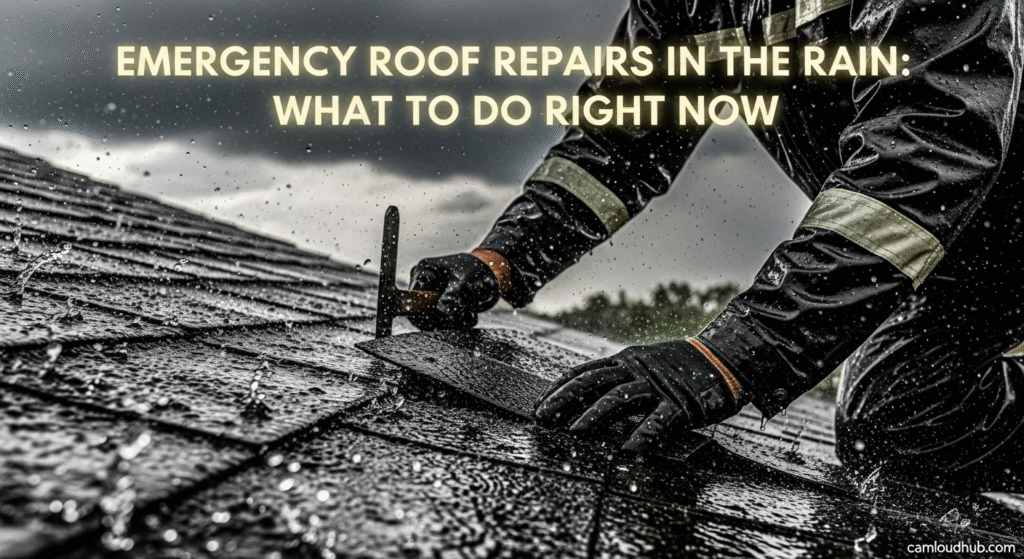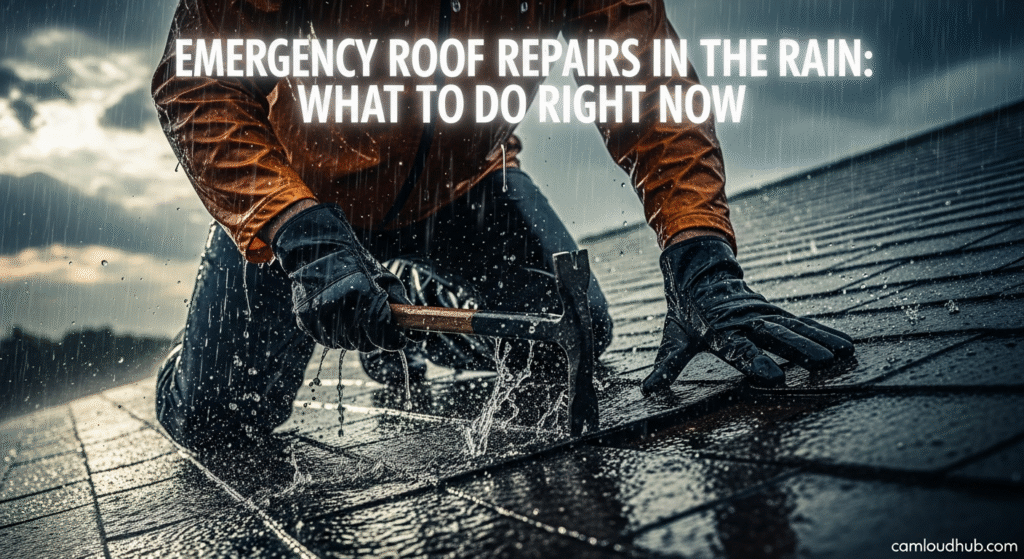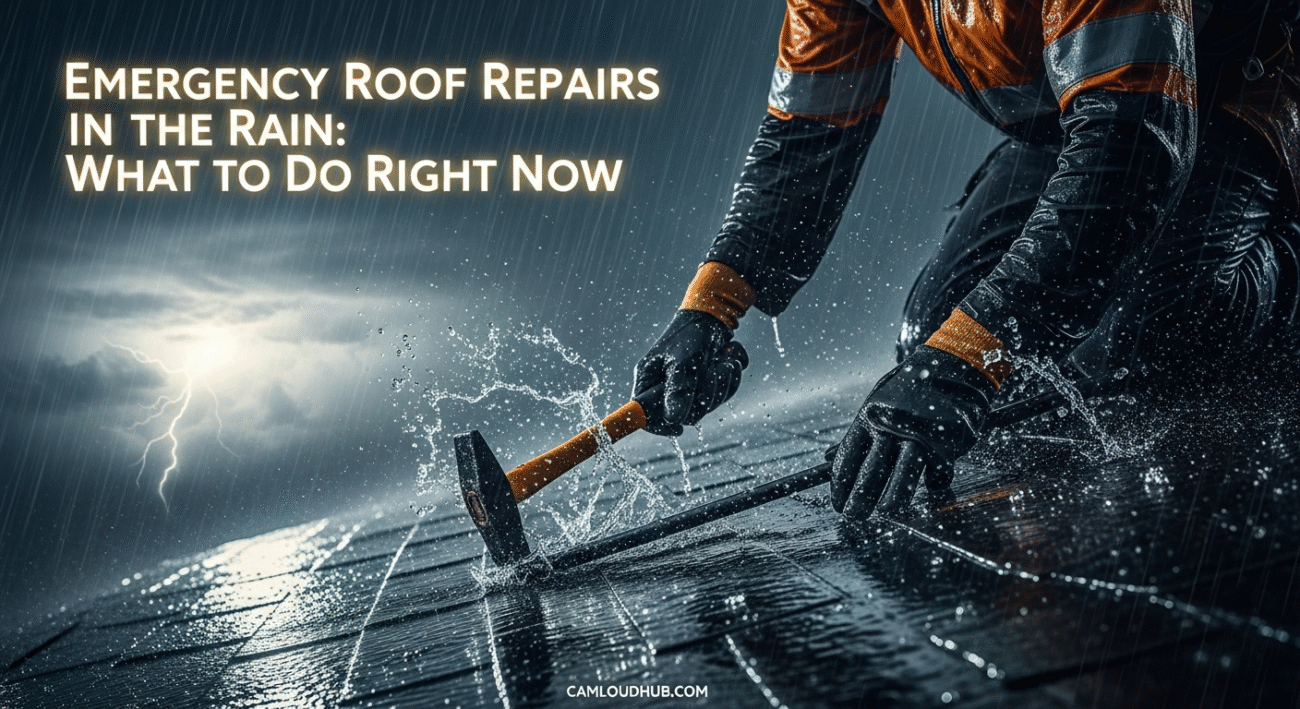Safety is Your #1 Priority (and Keep Calm!)
Emergency Roof Repairs in the Rain: What to Do Right Now – First things first, take a deep breath. Panicking won’t stop the water, but smart, calm action will. Before you do anything else, make sure everyone in the house is safe. Water and electricity are a dangerous combination, so always put personal safety first.
This isn’t the time to be a superhero unless you’re a professional equipped for treacherous conditions. Your main goal in an emergency roof repairs in the rain situation is to limit damage and prepare for full repairs later. Don’t climb onto a wet, slippery roof, especially during a storm, unless absolutely necessary and you know exactly what you’re doing. Seriously, it’s incredibly dangerous.

Immediate Indoor Actions: Contain the Chaos
You’ve got a leak, and it’s raining – what’s the very first concrete step? Go into damage control inside your home. Containing the water is crucial to preventing further interior destruction. Think of this as establishing your indoor perimeter.
Contain the Leak: Buckets, Tarps, and Trash Cans
Locate the source of the leak downstairs and place a bucket, large pot, or even a trash can directly underneath it. If the leak is spreading or dripping in multiple spots, you might need several containers. For wider areas, a large plastic tarp or even a shower curtain can be spread out on the floor, allowing the water to collect in a central point if you weigh down the edges slightly to create a dip. Remember, the goal is to collect the water, not just redirect it.
Empty these containers regularly to prevent them from overflowing and causing more issues. Keeping an eye on the water level will save you from another mess. This immediate containment is a critical step in any emergency roof repairs in the rain scenario.
Protect Your Belongings: Move & Cover
Once the immediate leak is contained, look around the area for furniture, electronics, rugs, or anything valuable that could be damaged by water. Move these items away from the leak path immediately. Even if the leak seems small, water can travel along ceilings and walls, causing damage far from its initial entry point.
If items are too heavy to move, cover them with plastic sheeting, tarps, or even old towels to provide some protection. This simple act can save you a lot of heartache and money down the line. Protecting your possessions is a key part of managing emergency roof repairs in the rain.
Electrical Safety: A Major Concern
Water and electricity are a deadly combination, and this cannot be stressed enough. If water is leaking near electrical outlets, light fixtures, or any wiring, turn off the power to that specific area or, if unsure, to the entire house from your main circuit breaker. This is a non-negotiable step to prevent electrocution or electrical fires. Don’t take chances here.
If you suspect any electrical components have gotten wet, do not attempt to touch them or restore power until a qualified electrician has inspected the situation. Your safety is paramount during emergency roof repairs in the rain.
Assessing the Damage (Carefully!): Where’s the Water Coming From?
Once the immediate indoor chaos is under control, you need to try and figure out where the water is actually entering. This assessment can help guide your temporary repair efforts or at least give you valuable information for the professionals. The key word here is “carefully.”
Looking from Inside: Attic Exploration or Cursory Glance
If you have safe access to your attic and it’s not a flooded mess, you might be able to go up there briefly to pinpoint the leak. Take a flashlight and look for water stains, drips, or actual puddles on the insulation or structural timbers. The point of entry might not be directly above where you see the water downstairs, as water can travel along beams. Be extremely cautious in the attic; watch your footing, avoid stepping through the ceiling, and absolutely do not touch any wiring.
If the attic isn’t safe or accessible, don’t worry about it. Just observe the leak from below. Look for wet spots on the ceiling, walls, or light fixtures. The pattern of the water can give you clues about where the damage might be on the roof, which is helpful information for eventual emergency roof repairs in the rain.
If It’s Safe: Quick Exterior Scan from the Ground
From the safety of the ground, take a careful look at your roof and gutters. Can you spot any obvious issues like missing shingles, lifted flashing around chimneys or vents, or debris clogging gutters that might be causing water to back up? This is a visual check only – no climbing ladders in the rain! What you discover can be immensely helpful for emergency roof repairs in the rain professionals.
Sometimes, a downspout is simply blocked, causing water to spill over the gutters and run down the wall, finding its way inside. Clearing a ground-level blockage might be safe and could alleviate some pressure. Again, prioritize your personal safety above all else.
Temporary Fixes During the Storm: Averting Disaster
Now for the tricky part: can you do anything to temporarily stop the leak from the outside during the rain? This is where extreme caution is absolutely critical. Remember, these are temporary fixes, designed to prevent catastrophic damage until the professionals can arrive and perform proper emergency roof repairs in the rain.
The Golden Rule: Only Attempt if Absolutely Safe
Let’s reiterate: attempting exterior temporary fixes during a heavy rainstorm, especially with high winds or lightning, is incredibly dangerous. If you are not comfortable or confident, or if the conditions are hazardous, do not try to climb onto your roof. Call a professional emergency roofing service immediately. They have the training, equipment, and experience to safely handle emergency roof repairs in the rain. Seriously, your life is worth more than a damp ceiling.
If the rain is very light, or has temporarily stopped, and you have safe, stable ladder access to a low-pitch roof, and you know exactly what you’re doing, then you might consider one of these temporary solutions. Always have someone spot you, and ensure your ladder is on stable ground.
Material Roundup: What You Might Need (and Why)
Before you even think about stepping outside, gather your materials. Having everything on hand reduces the time you’ll spend exposed to the elements. What you’ll need for emergency roof repairs in the rain often includes a few key items.
Tarps and Plastic Sheeting: Your Best Friends
A heavy-duty plastic tarp (at least 6-mil thick) is your go-to material for temporary roof patching during a storm. The bigger, the better, as you want it to extend well beyond the damaged area. Plastic sheeting can also work in a pinch. You’ll also need batten strips (thin strips of wood) or 2x4s, and screws or nails with wide heads to secure the tarp without tearing it. Some strong duct tape (the super-sticky, waterproof kind) can be surprisingly useful for minor fixes on flat surfaces or securing the edges of small patches, but it’s not a primary solution for large holes.
Roofing Cement, Flashing, and Plywood: More Advanced Options
For slightly more advanced temporary fixes, especially if you have a material mismatch, roofing cement (also called plastic cement or roof caulk) can be used to seal small cracks or holes or to reattach loose flashing. A sheet of plywood can be used to cover larger holes, but it will still need a tarp over it to make it waterproof. These items are generally for scenarios where the immediate rain has let up, or for more controlled emergency roof repairs in the rain situations handled by pros.

Step-by-Step Temporary Tarp Installation (if safe to access)
If you’ve assessed the situation and determined it’s reasonably safe to attempt a temporary tarp repair, here’s a basic guide. Again, do not proceed if conditions are windy, slippery, or dangerous. This is a very real emergency roof repairs in the rain operation.
First, identify the exact location of the leak on the roof. This might require some careful observation from the ground or a quick, safe ascent if conditions allow. The goal is to cover more than just the immediate leak area. You want to cover the entire section of damaged roofing, plus a generous overlap.
Unroll your tarp and position it over the affected area, making sure it extends several feet beyond the perceived damage in all directions. The higher edge of the tarp should be tucked under any overlapping shingles above it, if possible, to direct water over the tarp rather than under it. For most situations during a storm, you’ll just be laying it over the top.
Next, secure the tarp. This is critical, especially with wind. Place batten strips (thin pieces of wood or 2x4s) along the edges of the tarp, pressing them firmly against the roof. Screw or nail these strips into the roof structure, making sure to hit solid wood to prevent the tarp from blowing away. You want to create a tight seal without puncturing the tarp unnecessarily in the main water flow area.
Finally, ensure the tarp is snug. You can use additional batten strips across the middle of the tarp if it’s a very large area or if wind is a significant factor. The tighter the tarp is secured, the less likely it is to shift or blow off, reducing the risk of further damage and protecting your interior from continued leaks. This temporary measure is purely about preventing water intrusion in an emergency roof repairs in the rain scenario.
When to Call the Pros: Don’t Be a Hero!
Let’s be honest: not every homeowner is equipped or trained for roof work, especially not in a storm. In many, if not most, cases of emergency roof repairs in the rain, calling in the cavalry is the smartest and safest move.
You should definitely call professional roofers if:
- The leak is extensive and you can’t contain it indoors.
- You don’t feel safe climbing on your roof.
- The storm conditions are severe (heavy rain, strong winds, lightning).
- The damage is structural or involves a large hole.
- The leak is near electrical components, and you’ve already cut power.
- You simply lack the materials or know-how for even a temporary fix.
Many roofing companies offer 24/7 emergency services specifically for situations like this. They have the safety equipment, training, and specialized tools to perform temporary fixes safely, even in inclement weather. Look for local roofers with good reviews and inquire about their emergency response times. Explain that you need emergency roof repairs in the rain to prevent further damage.
After the Storm: Next Steps and Long-Term Solutions
The immediate crisis might be over, but the work isn’t done. Once the rain stops and it’s safe to assess everything thoroughly, it’s time to plan for permanent repairs. This long-term thinking is crucial after any emergency roof repairs in the rain event.
Your first step after the storm passes is to conduct a more thorough (but still safe) inspection of your roof and attic. Take photos of all damage, both inside and out. These photos will be vital for your insurance claim. Remove any temporary tarps or patches once you are ready for the professional repair. Have a professional roofer conduct a comprehensive inspection to identify all points of damage and assess the extent of the necessary repairs.
Don’t forget to contact your homeowner’s insurance company as soon as possible. Most policies cover sudden and accidental damage, which a roof leak during a storm typically falls under. Provide them with all the details and photos you’ve collected. Prompt communication is key to a smooth claims process. This ensures that your emergency roof repairs in the rain ultimately lead to a comprehensive, lasting solution.
Finally, hire a reputable roofing contractor for the permanent repairs. Get multiple quotes, check references, and ensure they are licensed and insured. Don’t just patch the problem; address the underlying cause to prevent future leaks. A proper, professional repair will give you peace of mind during the next storm.
Keeping Your Head Above Water
Experiencing emergency roof repairs in the rain is undoubtedly stressful, but remember, you’re not powerless. By focusing on safety first, taking immediate indoor containment actions, and making informed decisions about temporary fixes or calling professionals, you can navigate this challenging situation effectively. Being prepared with a basic emergency kit and knowing when to call for expert help are your best defenses against a leaky roof. Stay safe, stay calm, and get those leaks fixed!


